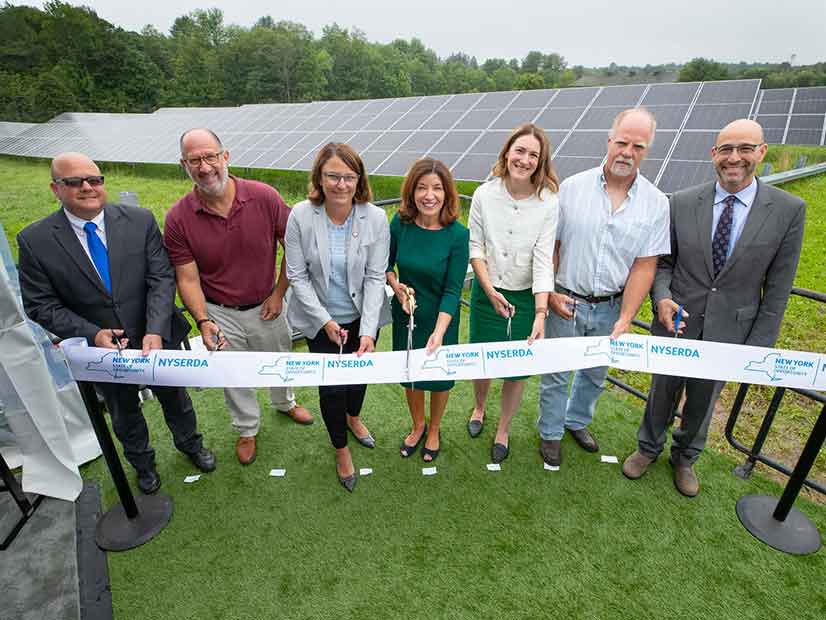New York’s community solar industry has had a great run over the last five years, but new dynamics are shaking things up for the market.
Community distributed generation (CDG) solar in New York is grappling with challenges that “cast a bit of a question on the market’s future,” Shyam Mehta, executive director of the New York Solar Energy Industries Association (NYSEIA), said Wednesday.
New York was number one in the country for community solar capacity installed in 2020, and by the end of last year, it was second in terms of cumulative deployments, Mehta said during a NYSEIA community solar webinar.
Mehta expects the state’s pipeline of mid- to late-stage projects will put New York in first place for cumulative deployments next year.
Leaders in the state celebrated the success of New York’s solar program on Tuesday, announcing 3 GW of total installed capacity to date. That’s half of Gov. Andrew Cuomo’s 6 GW target for 2025. Cuomo’s office said an additional 2.7 GW of solar is under development, 90% of which is community solar.
New York finalized its current CDG program in 2015, opening opportunities for people to collaborate on community projects to realize the benefits of clean energy when individual ownership is not an option.
Reaching 3 GW is a huge milestone, much to the credit of state officials, Emily Flanagan, managing director at Carson Power, said during the webinar. But today, she added, community solar developers face a “drastically different” set of challenges from the ones they experienced over the last five years.
“We’re seeing zoning codes that are … becoming incredibly stringent,” she said. “In the last couple of months, I’ve seen so many municipalities file amendments to their codes that are making it incredibly difficult to permit anything more than even five acres.”
In some districts, she said, the company has seen “huge attrition” on its projects because of those zoning changes.
Developers also are losing clarity on the incentives they have counted on through the state’s NY-Sun Megawatt Block Program, which is close to being fully subscribed.
If the state discontinues the block program and moves to a competitive solicitation format for CDG, it will “create a lot of market disruption,” Flanagan said.
It’s not clear in which direction the state will go, but Kelly Friend, vice president of policy and regulatory affairs at Nexamp, agreed that solicitations could be a problem.
“We would be disheartened and disappointed to see … that really dramatic shift in the market,” Friend said.
The solar developer supports the block approach, which sets a target along with incentives and allows the market and competition to reach that target.
“Solicitations don’t always work very well, so if that is the future of the New York market, I think we’re going to be challenged there,” she said.
CDG in NYC
The market for community solar in New York City is much different than the rest of the state — or country for that matter, said Ellie Kahn, senior policy adviser for the Mayor’s Office of Climate and Sustainability.
“We have more multi-family housing than anywhere else,” she said during the webinar. “We’re much more built up, so there’s a lot less space to build on.”
The region has the highest demand and the most carbon-intensive generation resources, and the electricity prices there are among the highest in the country.
“We really need as much renewable energy and storage as we can possibly get,” she said, adding that community solar unlocks rooftops when a building’s demand does not merit a behind-the-meter installation.
A predictable incentive for community solar is critical for developers focused on the downstate region. Projects in the pipeline there have a median size of 200 kW, which is much smaller than projects sited elsewhere in the state, according to Kahn.
They simply would not survive without an incentive to support the project economics, she said.
The city built incentives for community solar development into Local Laws 92, 94 and 97, which are part of a package of climate laws passed under the city’s 2019 Climate Mobilization Act.
LL 92 and 94, Kahn said, require solar or green roofs on all new buildings and renovations in the city, but a building owner does not have to match installed capacity to the building’s load.
“We want to encourage people to build as much solar as can possibly be built on their roof and do community solar remote net metering if they can’t use up all of the power themselves,” she said.
In addition, building owners get credit toward their carbon budget just for hosting community solar under building carbon reduction targets set by LL 97.
The city, she added, is still working to determine the exact value of that credit.


